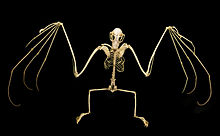Samoa fruit bat
| Samoa fruit bat | ||||||||||||
|---|---|---|---|---|---|---|---|---|---|---|---|---|

Samoa fruit bat ( Pteropus samoensis ) |
||||||||||||
| Systematics | ||||||||||||
|
||||||||||||
| Scientific name | ||||||||||||
| Pteropus samoensis | ||||||||||||
| Peale , 1848 |
The Samoa fruit bat ( Pteropus samoensis ) is a medium-sized species of the actual fruit bats (Pteropodini) within the bats . It is endemic to the South Pacific island groups of Samoa , American Samoa and Fiji .
description
The Samoa flying fox is a medium-sized species of flying fox with an average wingspan of 86 centimeters with an average wing area of 0.11 m 2 and a weight of 220 to 440 grams in the adult animals. There is no sexual dimorphism , so males and females do not differ in size or color. The body is dark brown, the fur color on the head, neck and back varies from sand to gray to brown. The hair is dark brown at its base and has lighter tips.
| 2 | · | 1 | · | 3 | · | 2 | = 34 |
| 2 | · | 1 | · | 3 | · | 3 |
The type has two front teeth (incisors), a canine (canine), three Vorbackenzähne (Praemolares) and two molars (Molar) in an upper jaw half and two cutting teeth, a canine, three Vorbackenzähne and three molars in the lower jaw half. The animals have a total of 34 teeth.
distribution
The distribution area of the Samoa fruit bat is limited to the South Pacific Samoa Islands ( Samoa and American Samoa ) and the islands of the state of Fiji . In Samoa it is only native to the islands of Upolu and Savaiʻi and in American Samoa to Tutuila , Ofu and Taʻū . In Fiji, he lives on Vatu Vara , Cicia , Vanua Balavu , Kadavu , Ovalau , Taveuni , Vanua Levu , Viti Levu and perhaps a few other medium-sized islands.
The species was originally native to Tonga , but became extinct here shortly after colonization.
The species prefers tropical rainforests as habitats , in whose canopy the animals live. However, they also occur in forest forests and plantations as well as in the area of localities.
Way of life
The Samoa fruit bats mostly sleep in large trees that protrude over the forest canopy. Unlike other fruit bats, they do not form “sleeping groups”, but mostly only sleep in pairs or in small families consisting of an adult couple and a young animal.
food
The Samoa flying fox feeds on the fruits and blossoms of the forest trees in the vicinity of its sleeping trees, but young coconuts, breadfruits and mangoes are also a welcome change. In the Samoa Archipelago he is active during the day and hardly ever out in the dark. In the Fiji archipelago, the species seems to be less active during the day.
Reproduction
The mating season of the Samoa fruit bats is from August to December, and during this time the females often take care of the young from the last litter. They usually give birth to a single cub, with births taking place from March to October with a focus on May to June. The young begin to fly on their own when they are about half the height of their parents, but the mother continues to care for them until they are about three quarters of the size.
Systematics
The Samoa fruit bat, along with around 60 species, is classified in the largest genus of fruit bats , the genus Pteropus . A distinction is made between two subspecies, Pteropus samoensis samoensis on the Samoa Islands and Pteropus samoensis nawaiensis on Fiji.
Threat and protection
The populations of the species are classified as relatively small and slightly declining, but the animals can be found regularly in both the Samoan Islands and Fiji. In the 1980s to 1990s, the population in Samoa and American Samoa, in particular, saw a dramatic decline due to storms, the clearing of forests on the islands, and direct hunting.
The species has been assessed by the International Union for Conservation of Nature and Natural Resources (IUCN) since 2008 as a type of the warning list (near threatened). This is justified by the relatively wide distribution on the South Pacific islands and the only slight decrease in population size in recent years. From 1988 to 1994 it was classified as endangered species, after which the status was downgraded to endangered (vulnerable) until 2008. The IUCN recommends an observation of the stocks, which could lead to a reassessment in the future.
supporting documents
- ↑ a b c d Stacie Holmes: Pteropus samoensis in the Animal Diversity Web of the University of Michigan Museum of Zoology. Retrieved January 3, 2012.
- ↑ a b c d Sandra Anne Banack: Pteropus samoensis . In: Mammalian Species . tape 661 , 2001, p. 1–4 ( full text (PDF; 194 kB)).
- ↑ a b c d e f Pteropus samoensis in the endangered Red List species the IUCN 2011. Posted by: A. Brooke, A., G. Wiles, 2008. Accessed January 3, 2012 found.
literature
- Sandra Anne Banack: Pteropus samoensis . In: Mammalian Species . tape 661 , 2001, p. 1–4 ( full text (PDF; 194 kB)).
Web links
- Pteropus samoensis in the endangered Red List species the IUCN 2011. Posted by: A. Brooke, A., G. Wiles, 2008. Accessed January 3, 2012 found.
- Stacie Holmes: Pteropus samoensis on the University of Michigan Museum of Zoology's Animal Diversity Web. Retrieved January 3, 2012.

